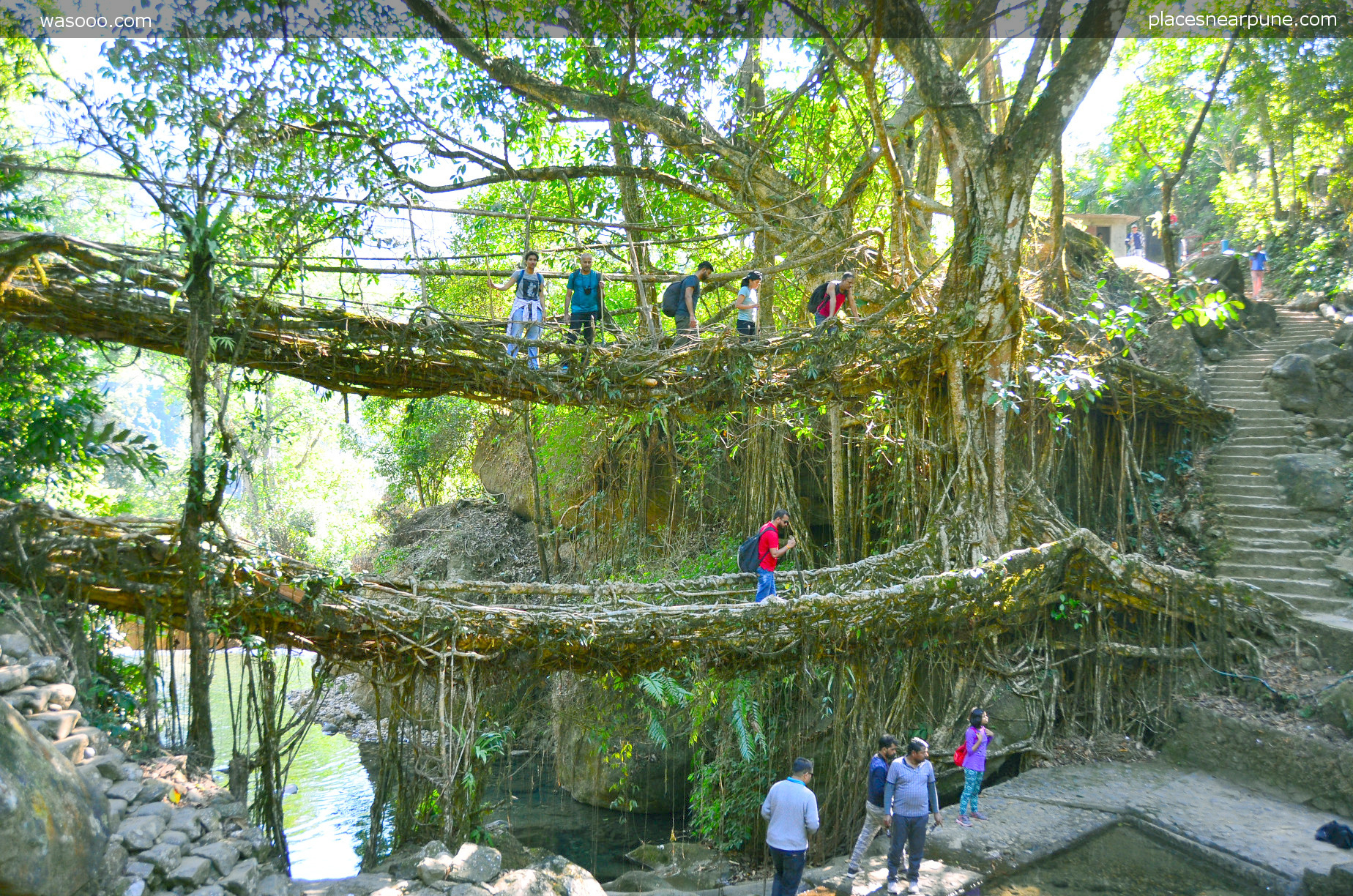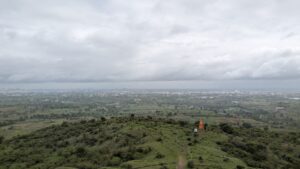
What are living root bridges?
Living root bridges are bridges across streams made by shaping/positioning the aerial roots/branches of Rubber fig trees. They are unique to Meghalaya. The local villagers shape the bridges by connecting the roots of trees from either side of the stream. Few interesting pts to note: A generation starts a root bridge, but the bridge takes many years to actually become functional. It means that the bridge will actually be used by the following generations. These bridges are quite strong – capable of holding dozens of people. They actually become stronger with age. They are called living bridges because they are made of roots and branches of living trees. There are 100s of such bridges all over Meghalaya. This particular one is “famous” due to its “double decker” nature.

Where is it and how to go?
This bridge is in a remote village Nongriat. It involves a walk/trek from a village on the main road, Tyrna. The trek involves a total climb of around 3000 steps one-way. It is not a trail, but steps all the way. You have to climb down to the river and then climb up to Nongriat. There is no option but to walk.


Is it to tough that only foreigners and athletes can do it?
Definitely not. Yes, it is tough, but more of a mental challenge rather than a physical one. If you take your time, you will easily cover it. There were people who started at 7 AM and were back by 10. They were more of a “ticked off the bucket list kind”. We started at around 9 AM and we were back at the parking at around 5. Lots of photos, kid breaks, snack breaks and a long lunch break at the pool, it was a relaxed day. There are few small villages on the way where you can get snacks and cool drinks to keep you hydrated. Doing this trek in the summer will be tough, i wouldn’t attempt it. Monsoon will be awesome in a different way. Yes, the rains and slippery treks would be a pain, but the gain would be unmatched greenery. Btw, the coloured pools will not be so in the rainy season.
Can kids manage the trek?
In fact, kids easily can. It is only the adults who have second thoughts. We were in a group with 6 kids – of all ages. My youngest was 3. She walked half the way. The other half, we carried. That too was because she was bored – as the other kids would move way ahead. If you are not sure, you can always take the help of the guide who can carry your kid for a while.
Do you need a guide?
Technically no, as the path is straight forward and there are lot of people on the way to guide you at forks. But it is recommended. One, it helps the locals. Two, if you get stuck due to whatever reason, a local with you (and the helping nature that Meghalayans are) wil ensure that you have adequate support.
Where do i stay?
The most popular one is the Cherapunjee Holiday Resort. The owner of the resort was part of a team which discovered the bridge (ad many more) and helpes popularise it thus making the entire area open up to tourism. The resort has a great view towards the Bangaldesh plains. BUT, i found the resort to be a bit expensive considering the Meghalayan standards. The main cost factor comes in with kids/extra beds. So, a family of 4 (2 adults and 2 kids) would end up paying more than 6K for a night (incl bfast and dinner), which is expensive for the area. If you have a vehicle, you can pretty well stay in main Sohra town and drive over to Tyrna (1 hr drive). We stayed in CHR the previous night, finished the trek and drove over 1.5 hrs to north of Sohra for our stay.
If you are the backpacker kind, there are few basic options in Nongriat itself, the most popular one being the Serene home stay. But remember that these are very basic in nature with no luxuries. And you obviously cannot be with lot of luggage climbing on these steps.

Any add-ons?
On the way, you have many attractions which deserve a stopover. A small deviation will take you to the longest root bridge. You can cross over to the other side and come back through the river (depending on the season). You also cross two metal bridges on the way. If you have never been to any adventure camp that had a Burma bridge crossing, this can be a bit scary. Otherwise this adds to the trek’s interesting points.


At the second bridge crossing, you have pools below. During lean water times (e.g. Winter, when we were there), the water turns a beautiful blue (depends on the time of the day and the direction from which you are looking at it). Also, it is amazingly clean and transparent. We took ur long lunch break at this place with the kids having lot of fun.


Meghalaya is famous for its big spiders. If you watch carefully enough, you can see a lot of them on this trek and they are BIG. The most common one is the giant wood spider with its distinctive golden coloured markings on the back.

A small trek beyond the double bridge will take you to more freshwater pools. Most of the crowd returns from the bridge. An hr beyond will take you to te rainbow falls. And even further can take you to Nohkalikai falls making it an wholesome trek. But then you have to plan the pickups if you plan to go until Nohkalikai.
Most of the regular tourists on a planned itinerary with Shillong as the base do no go to the double bridge. But this place is not to be missed for its natural beauty and uniqueness. Make sure you include it on your itinerary. Have any doubts, drop a comment or a message and i can help.


